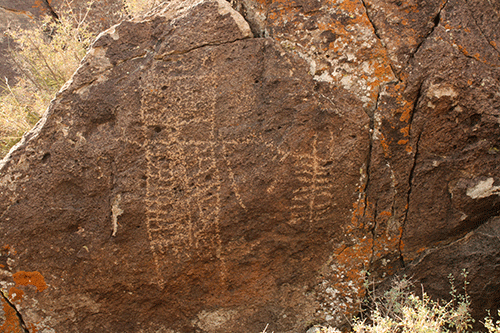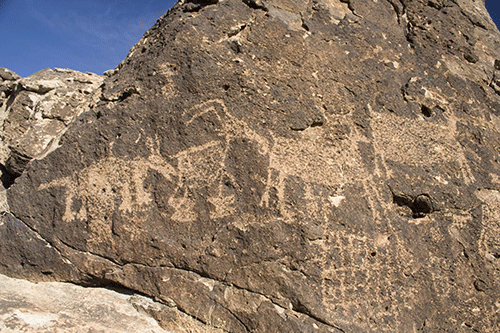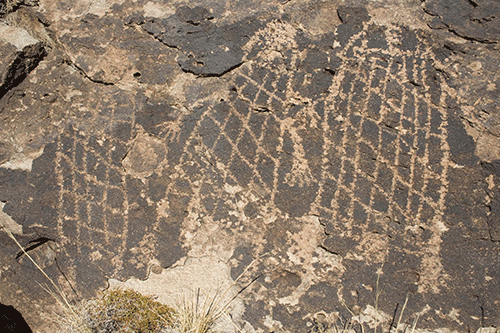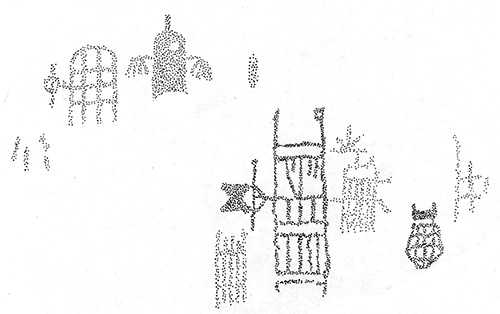Delamar Flat
The Delamar Flat site is a large rock art site and temporary campsite in Lincoln County, southeastern Nevada. Although Delamar Flat is well-known for its Pahranagat-style rock art, it had not been intensively recorded before 2012. The goals of our project were to inventory the site’s archaeological features, evaluate its heritage significance, and assess the site’s management needs. The project was made possible by an award from Round 4 of the Lincoln County Archaeological Initiative, with fieldwork carried out in fall 2012.
Delamar Flat is located a hill composed of welded tuff, exposed as bedrock and large boulders, forming colluvial slopes and low cliffs. The site comprises 208 rock art panels and habitation debris indicative of a temporary campsite. Rock art is distributed along a 420-m (N/S) stretch of the hill and extends to the hilltop in places. It is concentrated in an area 150 x 50 m at the foot of the slope and midslope.
The associated habitation debris is the residue of repeated short-term occupations that either reflect brief hunting-foraging expeditions made to exploit seasonally available resources, or economic activities necessary to sustain site visits for primarily sociocultural purposes. This debris spans the Middle and Late Archaic but with a Late Archaic focus.
Delamar Flat is one of the largest rock art sites in southeastern Nevada, containing 208 rock art panels and 598 individual motifs. Stylistically and thematically, the site’s rock art is comparable to other sites in the region, but is notable for containing a large number of Pahranagat-style anthropomorphs, as well as abstract and stylistically undifferentiated figurative designs representative of Basin and Range tradition types.
Curvilinear motif types account for about 20.4% of the motif assemblage, which is comparative to the regional average of 25%. The range of curvilinear motif types is rather narrow, largely restricted to circle variants, dots, rare spirals, arcs, and serpentine lines. Six circles bisected by long vertical lines were noted in addition to those that are combined with 12 PBAs and possibly are schematic portrayals of atlatls.
Rectilinear motif types make up 25% of the motif assemblage, a higher proportion than the regional average of 14%. These include a number of rectangular forms that could be schematized PBAs—these have internal decoration and/or a fringe but lack sufficient formal attributes to be positively identified as PBAs. Rectilinear designs also are represented by a rather restricted set of motif types. Rake-like designs are the most common rectilinear motif type. Many of these have their tines formed by columns of dots, and a reminiscent of the linear arrangements of dots at Black Canyon type site for the Pahranagat Style. Simple linear forms (various usages of lines) occur slightly less frequently than at other sites in the region. These occur singly or are arranged in short rows and columns. These simple lines tend to be informally executed and may be more performative in character (i.e., the act of making a mark on the landscape was the primary motivation for their production).
Bighorn sheep figures are the most abundant identifiable motif type (82 motifs), but their frequency (13.7% of the site’s motif assemblage) is in keeping with the general regional picture. Other zoomorph types are rare but include portrayals of a bear paw print, a deer, four canids, and two lizards. The bighorn sheep figures are represented by a range of body styles and include several large examples. They are found on 47 panels and co-occur with other bighorn sheep figures. They tend not to form narrative scenes, with the exception of one panel that apparently portrays a row of sheep being chased by a canid.
Anthropomorphs, other than Pahranagat-style figures, are strikingly rare at the site; only one stick-figure anthropomorph and eight non-stick-figure anthropomorphs that could not be identified to a specific style. Delamar Flat’s significance derives from its being the second largest assemblage of Pahranagat-style anthropomorphs in the region. The site contains at least 59 motifs in this anthropomorph style. 45 examples of the PBA type, 12 of which hold a circle bisected by a vertical line that are conventionally identified as atlatl portrayals; and 14 examples of the solid-body variant. In addition, the site contains 26 rectangular forms that have internal decoration or other attributes that could possibly be identified as schematized PBAs. These Pahranagat-style anthropomorphs make up 10% of the motif assemblage.
Many of the site’s Pahranagat-style figures are very well made and formal. The two variants (PBA and solid-body) are only placed together on three panels—their discrete distribution at the site is suggestive of possible chronological differences between these types and stylistic development. However, they do not occupy mutually exclusive areas. The PBAs exhibit a wide variety of forms (though all are variations on linear internal decoration), ranging from elaborate to much more schematic and elemental types, the further study of which might clarify the developmental sequence of this style. The solid-body variants are notable for being visually imposing because of their scale, topographic location, and quality of execution, a characteristic shared with other examples of this type at other sites.
This anthropomorph style is a relatively rare and narrowly distributed type, known from about 26 sites but only occurs in large numbers near Black Canyon, Shooting Gallery, and Mount Irish. The PBA variant is the most common expression of this style; for example only 17 examples of the solid-body type are present at Black Canyon and 14 at Delamar Flat. The Pahranagat Style is traditionally assigned to the Middle and Late Archaic based on PBAs apparently wielding atlatls and its associated archaeological contexts.
Overall, it appears that the Pahranagat Style represents a developmental sequence from PBAs (with their origins in the Middle Archaic) to solid-body types during the Late Archaic. The greater abundance of PBAs could perhaps also be cited as evidence of greater antiquity in this sequence. A general transition is evident from a standardized body morphology with wide-ranging internal decoration (an assertion of the collective while recognizing individual differences) to a body morphology with limited variation and no variability in body decoration (an assertion of a collective identity denying individual differences). The differences in frequency between PBAs and solid-body variants could also reflect that the latter symbolize a more restricted membership in the collective social identity symbolically treated through Pahranagat Style rock art.
Delamar Flat is illustrative of a wider regional phenomenon during the Late Archaic that sees the emergence of idealized representations of the human form in rock art. The Pahranagat Style is perhaps reflective of the localized expression of social practices or institutions that are associated with cultural developments elsewhere in the southwest and eastern Great Basin concomitant to the adoption of semi-horticultural economies. The Pahranagat Style presumably represents Archaic or Numic hunter-foragers adopting cultural traits associated with the social practices of Fremont and Puebloan groups to the east and south. The ideological treatment of sociocultural changes in those societies appears to be manifested in formally distinct anthropomorphs in rock art and other material culture. Bordering these cultural developments, the Pahranagat Style could be viewed as evidence that cultural information as well as material culture may also have been a way that segments of society acquired prestige by demonstrating a connection with an exotic lifestyle and social practices of the southwest and east.






